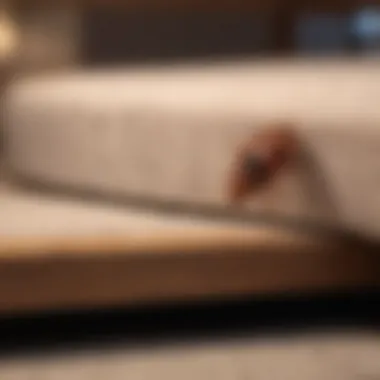Can New Furniture Bring Bed Bugs into Your Home?


Intro
When it comes to home furnishings, many people often overlook the possibility of encountering bed bugs in new furniture. The concern may seem misplaced, given the commonly held belief that bed bugs are primarily a problem in dirty or used items. However, recent data reveals that new furniture might also pose a risk. Understanding the nuances of this issue can help consumers make informed decisions.
Fascinating Facts About Bed Bugs
Bed bugs are intriguing creatures with a unique biology and behavior.
Unique Characteristics
Bed bugs, or Cimex lectularius, are small, wingless insects that feed primarily on the blood of humans and animals. They are flat and oval-shaped, making it easier for them to hide in the seams of mattresses and furniture. Adult bed bugs can grow up to 5 mm in size and have a reddish-brown color.
Extraordinary Abilities
These pests are remarkable in their resilience. A single female bed bug can lay hundreds of eggs over her lifetime, which can result in a swift infestation. They are also capable of surviving without a meal for several months, which allows them to wait for the right opportunity to re-infest a space.
Understanding Bed Bug Behavior and Habitat
To combat potential infestations, it is crucial to understand where bed bugs thrive and how they behave.
Natural Habitats
Bed bugs are typically found in sleeping areas, as they are nocturnal. They tend to hide in the cracks and crevices of furniture, behind wallpaper, and in bed linens. It is important to note that while the primary focus is on bedding, bed bugs can inhabit new furniture, particularly if it comes from a source with a high risk of infestation.
Social Structures
Unlike many social insects, bed bugs do not have a complex social structure. They are solitary feeders, with males and females coming together primarily for mating. However, they do gather in groups to feed, which can increase the likelihood of infestation in shared living environments.
Preparedness Against Bed Bug Infestations
Awareness is essential in mitigating the risk of bed bugs. Below are some tips to minimize potential issues with new furniture:
- Inspect Before Buying: Always check new furniture for any signs of bed bug activity, including stains or shed skins.
- Maintain Cleanliness: Regular cleaning can help reduce the appeal of your living space to bed bugs.
- Use Protective Covers: Mattress encasements designed to prevent bed bug entry can be beneficial.
Maintaining a pest-free environment requires vigilance. Knowing where to look and what to avoid is essential.
Recent Discoveries in Bed Bug Behavior
The emergence of new studies on bed bugs has provided greater insight into their behavior, which in turn informs prevention strategies.
Latest Research Findings
Current research highlights that bed bugs may be developing resistance to certain insecticides. This resistance complicates efforts to eliminate infestations and underscores the importance of preventive measures.
Finale
Understanding the dynamics surrounding bed bugs and new furniture is essential for consumers. With the right knowledge and strategies, it is possible to minimize the risk of bed bug infestations, thereby ensuring a more comfortable living environment.


Understanding Bed Bugs
Understanding bed bugs is essential in the context of this article. Their biology and behavior play a crucial role in determining how they may be involved with new furniture. Recognizing what these pests are, how they reproduce, and the signs of an infestation can empower consumers to make informed decisions when acquiring new furniture. This knowledge not only helps in recognizing the possibility of bed bug infestations but also facilitates effective prevention techniques. It is vital for anyone concerned about the impact of these pests on their living environment to grasp the intricacies associated with bed bugs.
What Are Bed Bugs?
Bed bugs, scientifically known as Cimex lectularius, are small, wingless insects that feed on the blood of humans and animals. Adult bed bugs typically measure about 4 to 5 millimeters in length. They have a flattened, oval shape, allowing them to hide in small crevices. These pests are primarily nocturnal, coming to feed during the night when their hosts are asleep. Generally, bed bugs are not known to transmit diseases; however, their bites can lead to discomfort and allergic reactions, making it crucial to address any infestations promptly.
Life Cycle of Bed Bugs
The life cycle of bed bugs consists of several stages: eggs, nymphs, and adults.
- Eggs: Female bed bugs lay approximately 200 to 500 eggs in their lifetime. These eggs are tiny, about 1 millimeter in size, and take about a week to hatch, depending on environmental conditions.
- Nymphs: Upon hatching, the nymphs are translucent, resembling miniature adults. They undergo five molts before reaching maturity. The nymph stage can last anywhere from a few weeks to several months, depending on the availability of blood meals.
- Adults: Once fully mature, bed bugs can live for several months to even a year, without feeding. Understanding this cycle helps in addressing infestations effectively since both nymphs and adults can hide in various furniture parts.
Signs of Infestation
Identifying the signs of a bed bug infestation is key in preventing further issues. Common indicators include:
- Bites: Bed bug bites often appear in clusters or lines on the skin. They are commonly red and itchy.
- Stains: Dark spots on bedding or furniture may indicate bed bug excrement. These stains are usually small and can easily go unnoticed at first.
- Eggs and Shells: Evidence may also include the presence of eggs and shed skins in the vicinity of suspected hideouts, such as seams and crevices of mattresses.
Recognizing these signs early is crucial for effective intervention and helps to mitigate the potential spread of bed bugs. Ensuring thorough inspections when acquiring new furniture can greatly minimize risks associated with these pests.
The Role of Furniture in Bed Bug Transmission
Understanding how bed bugs transmit through furniture is crucial. Many people do not realize that while bed bugs primarily inhabit bedding and mattresses, furniture also plays a significant role in their spread. New furniture can inadvertently introduce these pests into a home, leading to unwanted infestations. Knowing how to protect your living space is fundamental for any homeowner or renter concerned about bed bug risks.
How Bed Bugs Spread
Bed bugs, scientifically known as Cimex lectularius, are adept at hitching rides on various objects, and furniture is no exception. They can attach themselves to clothing, bags, or even boxes that contain the furniture. In many cases, a customer may purchase new furniture, thinking it is unaffected, when in fact, this is not always the case.
Bed bugs do not fly, but they can crawl quickly. They are especially active at night when they feed on blood. It is essential to note that bed bugs can travel between rooms in multi-unit buildings through electrical outlets or piping. This ability makes even minor furniture movements a potential risk, as furniture can serve as a bridge for these pests to spread from one area to another. Flat-packed items sold in stores like IKEA can pose a higher risk, as they are often stored in large warehouses where bed bugs can easily find a way in and out.
Common Hiding Spots in Furniture
Bed bugs are experts at finding hiding spots within furniture. Knowing where they usually settle can help in both prevention and detection. Common areas include:
- Seams and Crevices: The seams of chairs or couches are prime spots. Bed bugs can slide into these small openings and lay eggs.
- Under Cushions: Furniture pads, especially if not frequently removed or cleaned, can trap bed bugs beneath them.
- Inside Drawers: Nightstands and desks offer plenty of nooks where bed bugs can settle.
- Wooden Framework: Beds with wooden frames can harbor bed bugs in cracks or behind the headboard.
- Fabric and Upholstery: Any textile surface can be a haven for these pests, making upholstered furniture particularly vulnerable.
Important: Regular inspections of all furniture, including new items, are crucial to catch potential infestations early.
Recognizing these common hiding spots will aid in ensuring a pest-free environment when introducing new furniture into your space. By being proactive, it is possible to minimize the risks associated with furniture and bed bugs.
Sources of Bed Bugs in New Furniture
Understanding the sources of bed bugs in new furniture is crucial for any consumer. When purchasing new items, especially upholstery, one might not think about bed bugs. However, comprehending the processes involved in bringing that furniture into your home can reveal potential risks. Recognizing these sources aids individuals in making informed decisions and effectively minimizing their exposure. Being proactive rather than reactive is key.
Manufacturing and Shipping Processes


The journey of new furniture begins at the manufacturing stage. Factories are environments where materials are gathered and crafted into products. These locations can be susceptible to bed bug infestations. If the factory has an existing bed bug problem, tiny, adult bugs can hide within the crevices of furniture pieces during production. Additionally, discarded products can harbor infestations.
Once furniture leaves the factory, it enters the shipping process. Trucks and containers can pick up bed bugs if shipments are loaded in infested areas. They may even hitch a ride on other items. Therefore, it is not just the furniture itself that one should worry about but also the entire logistics chain.
Some tips to mitigate risks in this stage are:
- Ask about the source of materials: Understanding where the furniture was made can provide insights into possible pest issues.
- Inquire about inspection protocols: Many manufacturers have regular checks to ensure bed bugs do not lurk during production.
Retail Environments and Risks
Retail settings play a significant role in the transmission of bed bugs to consumers. Stores can get shipments of furniture from various manufacturers. If any shipment has bugs, they might infest the store's display items or stock. Moreover, high foot traffic means customers may arrive with bed bugs on their clothing or bags and inadvertently transfer them to furniture.
Moreover, during clearance sales or returns, items might not undergo thorough inspections. This increases the risk for unwary consumers. It is essential to consider these factors when purchasing new furniture from retail stores.
Some preventive actions include:
- Inspect items closely: Checking seams, joints, and cushions can reveal signs of bed bugs.
- Choose established retailers: Familiar brands often have stricter pest management policies and better practices.
Remember: The key to preventing bed bug problems starts long before the furniture enters your home. Staying vigilant and checkiing in various stages can make a significant difference.
Preventive Measures When Buying New Furniture
When considering a purchase of new furniture, understanding preventive measures is crucial. Bed bugs can easily hitch a ride on new items, creating issues in your living space. Thus, engaging in proactive strategies can significantly reduce the risk of introducing these pests into your home. Knowing the potential sources of infestation and how to safeguard against them is essential in maintaining a healthy environment.
Inspection Tips Before Purchase
Before you make your final decision on any piece of furniture, careful inspection is vital. Here are some specific tips for what to look for:
- Examine Fabric and Upholstery: Look closely at upholstered pieces. Check seams, creases, and any upholstery folds that can conceal bed bugs.
- Inspect Drawers and Hidden Areas: Open drawers and compartments. These are common hiding spots for insects. Look for any signs of live bugs or dark stains, which could indicate their presence.
- Check the Base or Legs: Furniture legs or bases can be breeding grounds. Pay attention to these areas for any signs of infestation.
- Use a Flashlight: Often, bed bugs can hide in very small spaces. A flashlight can help reveal these hiding spots that you might otherwise overlook.
Taking your time to carry out a thorough inspection can help prevent bringing bed bugs into your home. Taking just a few extra moments to scrutinize a potential purchase could save you from a future infestation.
Choosing Reputable Retailers
The retailer from whom you purchase your furniture plays a significant role in bed bug risk. Opting for reputable retailers can provide additional safeguards. Here are several factors to consider:
- Research Customer Reviews: Look for reviews regarding the retailer's pest management practices. Customer feedback can offer insights into their standards of cleanliness and safety.
- Ask About Their Inspection Practices: Ensure the retailer has in place effective measures to inspect their inventory for pests. This often indicates their commitment to quality.
- Consider Local vs. Online Retailers: Local retailers may allow you to physically inspect items in store, which can be beneficial. Online options should have clear return policies in case you find any issues post-delivery.
- Investigate Warranty Offers: A reputable retailer often provides a warranty or guarantee. This can be indicative of their confidence in the quality of their products.
Ultimately, choosing where to buy your furniture can influence your exposure to bed bugs. Opting for trusted retailers minimizes the likelihood of bringing unwanted pests into your home.
Handling Potential Infestations
The prospect of bed bugs invading a living space is unsettling. Understanding how to handle potential infestations is crucial. This section will provide a roadmap for individuals who may suspect a problem or have already encountered evidence of these pests. Taking immediate action can prevent further issues.
Immediate Steps to Take
When one suspects bed bug presence, swift action is necessary. Here are critical steps to follow:


- Isolate Affected Areas: Start by isolating the area where the infestation is suspected. Do not move items from this space to prevent spreading bed bugs.
- Inspect Furniture and Belongings: Use a flashlight to carefully check furniture, especially seams, and crevices where bed bugs like to hide. Pay close attention to the mattress, box spring, and headboard.
- Seal Items in Plastic Bags: Any infested items or belongings should be sealed in plastic bags. This action helps contain the problem and stops bed bugs from moving around.
- Wash and Dry Clothes: Use hot water to wash bed linens, clothing, and any fabric items. Then dry them on high heat, which effectively kills bed bugs at all life stages.
- Vacuum the Area: Use a vacuum cleaner with a brush attachment to thoroughly clean affected locations. After vacuuming, dispose of the vacuum bag or empty the canister outside the home.
- Monitor for Activity: Continue to observe the area for signs of bed bug activity, like shed skins or fecal spots. This tracking can help determine if the pest control method is working.
These steps can prove essential in managing a potential problem with bed bugs. Prompt action not only leads to a quicker resolution but also minimizes the chance of a larger infestation.
When to Call a Professional
In certain cases, taking matters into one’s own hands may not be effective. Knowing when to call a pest control professional is important. Here are some indicators:
- Persistent Signs of Infestation: If there is ongoing evidence of bed bugs after your immediate efforts, a professional's intervention may be necessary.
- Large Infestation: When an infestation spreads beyond a single area or piece of furniture, it is time to seek professional treatment.
- Health Concerns: If there are allergic reactions or significant skin irritations among household members, medical concerns should be primary. Receiving professional help ensures a thorough eradication process that protects health and well-being.
- Lack of Experience: If unsure about identifying or treating bed bugs, relying on experts is wise. They have experience and tools necessary to manage infestations properly.
Long-Term Prevention Strategies
Long-term prevention strategies are crucial in the battle against bed bugs. Understanding how to create an inhospitable environment can significantly reduce the risk of these pests invading your home. By implementing thorough preventive measures, homeowners can maintain peace of mind and ensure that their living spaces remain free from infestations.
Creating a Bed Bug-Free Environment
To create a bed bug-free environment, several key factors must be considered. First, it is essential to regularly inspect all areas of your home, especially bedrooms and common sitting areas. Pay close attention to seams and crevices in mattresses and upholstered furniture. Bed bugs are small and can hide in these areas quite effectively.
Another critical aspect is decluttering. A tidy environment limits the number of hiding spots available for pests. This includes reducing the clutter around beds as well as eliminating unused items from closets and storage spaces. Storage bins with airtight lids can also protect belongings from potential bed bug intrusion.
Additionally, using protective covers on mattresses and box springs can serve as a barrier against bed bugs. These covers should be specifically designed to be bed bug-proof, which helps safeguard your sleeping areas. Regular wash and high heat drying of linens and blankets further discourages bed bug presence.
Ongoing Monitoring Techniques
Ongoing monitoring techniques are vital to ensure that any potential infestation is detected early. Regularly checking areas known to be susceptible to bed bugs can save time and money. You might consider implementing the following techniques:
- Visual Inspections: Conduct periodic checks in areas where bed bugs are likely to hide. Look for signs such as dark spots, shed skins, or live insects.
- Trap Usage: Bed bug traps are an effective way to monitor for activity. Place interceptors under bed legs and furniture to catch any bed bugs that may attempt to climb up.
- Surveillance Programs: If you live in a multi-unit building, participating in organized surveillance programs can help monitor infestation risks collaboratively with neighbors.
- Mobile Apps: Some apps help track sightings and reports of bed bugs. Utilizing technology can improve your approach to monitoring.
- Professional Inspections: Consider annual inspections by pest control professionals. These experts have the training and tools necessary to spot infestations before they escalate.
Regular monitoring and the implementation of proactive measures contribute significantly to a bed bug-free life. Early detection is key in minimizing the extent of an infestation.
By investing time and effort into these long-term prevention strategies, individuals can create a more resilient home environment. This proactive approach ultimately contributes to the overall comfort and health of all residents.
Epilogue: Making Informed Decisions
In the context of new furniture purchases, making informed decisions becomes crucial in preventing bed bug infestations. Understanding how bed bugs can find their way into homes through new items can significantly impact choices for consumers. This understanding empowers individuals to proactively engage in preventive measures, limiting potential risks.
Realizing that bed bugs can exploit various paths, from manufacturing to retail environments, highlights the importance of vigilance. A buyer who is aware of the risks associated with newly acquired furniture is more likely to inspect items thoroughly before bringing them into their living spaces. This awareness not only helps protect personal belongings but also fosters a habitual practice of maintaining an overall pest management strategy.
Key benefits of making informed decisions include:
- Enhanced awareness of bed bug signs and behaviors.
- Improved inspection skills to identify potential infestations.
- Increased likelihood of selecting reputable suppliers who prioritize pest control.
Consideration must also be given to how these choices affect long-term living environments. An informed consumer can adopt strategies that ensure the furniture they buy does not serve as a vehicle for bed bugs, thus supporting a healthier home.
An educated choice today can prevent a headache tomorrow.
Recap of Key Points
- Bed bugs can travel in various ways, including through new furniture.
- Vigilant inspection before purchase can minimize risks.
- Reliable retailers often implement protocols to reduce infestation risks.
- Ongoing monitoring and proper maintenance are essential for keeping living spaces pest-free.
Final Thoughts on Bed Bug Risks
The risks associated with bed bugs in new furniture cannot be ignored. Education is paramount. Every consumer should be encouraged to delve deeper into understanding the nuances of bed bug behavior and the routes they take to invade homes.
Ultimately, while new furniture can enhance comfort and aesthetics, it also comes with the possibility of hidden threats. Taking proactive steps and fostering awareness about bed bugs will make all the difference. By integrating these practices into purchasing routines, individuals can help ensure that their homes remain safe havens, free from these unwanted pests.







